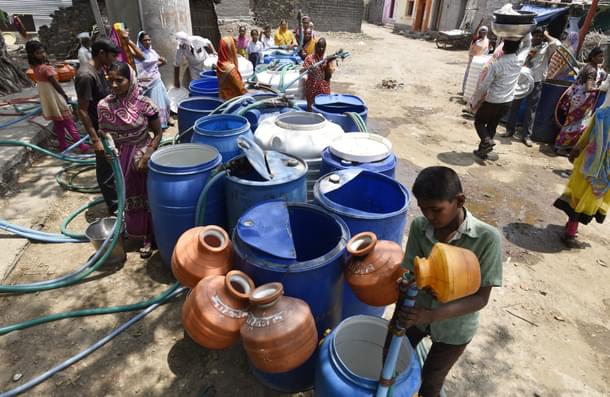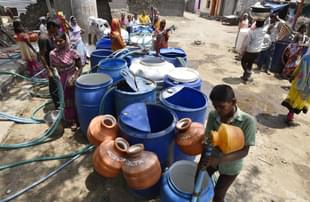Ideas
How Climate Change Stakeholders Can Raise Capital To Weather The Storm
Nibu Pullamvilavil
May 26, 2018, 11:18 AM | Updated 11:18 AM IST
Save & read from anywhere!
Bookmark stories for easy access on any device or the Swarajya app.


Last week, a dust storm raged over Uttar Pradesh and Rajasthan resulting in the death of 120 people. This has raised concerns over extreme weather phenomena and their causal links to anthropogenic climate change.
The debates surrounding climate change over the last decade have revolved around mitigative efforts such as the increased uptake of renewable sources of energy, increased energy efficiency and decarbonising travel while the focus on adaptive efforts has been minimal.
So why is adaptation necessary?
There are two major policy responses to climate change namely mitigation and adaptation. Mitigation addresses the root causes and focuses on reducing future greenhouse gas emissions, while adaptation seeks to lower the risks posed by the effects of climatic change. Even if we successfully reduce emissions over the next decade, adaptation will still be necessary in order to deal with the short-medium terms risks associated with carbon emissions released over the last century. Adaptation measures include, but are not limited to, building defences to protect against sea-level rise, deployment of early warning systems against cyclones, revised building codes, crop diversification, micro-irrigation and increased penetration of weather insurance.
According to an HSBC report published in March 2018, India is amongst the most vulnerable nations to the effects of climate change. The highest risks related to climate change are concentrated among the low-income groups living in houses, which are especially vulnerable to wind and water hazards due to extreme weather events. Mumbai, Kolkata and Chennai are especially prone to bear the brunt of climate change.
Nearly 54 per cent of India faces high to extremely high water stress. There will be increased pressure on water resources as increased periods of low precipitation and dry spells occur due to climate change. This stress on water resources will have far-reaching implications on India’s food security.
Climate change has also the potential to reverse India’s achievements in reducing diarrhoea-related deaths (Ramachandran, 2014). This further widens the class divide as children living in poor rural areas and urban slums are at higher risk of morbidity and mortality from diarrhoeal diseases.
Climate change has an impact on labour productivity with a study estimating that a maximum temperature of 37◦C can result in over 101 million lost work hours nationwide. The same study states that climate change can increase the number of annual conflicts with a one standard deviation increase in temperature corresponding to an average effect of an 8.8 per cent increase in conflict.
The severity of extreme climatic events can be alleviated through a process of prevention and relief. The focus of central and state governments has been on palliative adaptation (relief) and not preventive adaptation. This approach is myopic as preventive adaptation would mitigate the adverse impact probability therefore reducing the need for palliative action. Preventive adaptation also ensures that palliative adaptation is far more effective in resource utilisation thereby reducing the impacts of the shock.
We have had some success in preventive adaptation and the State of Odisha is a case in point.The super-cyclone that struck Odisha in 1999 killed 9,843 people. However 14 years later, when the equally powerful Cyclone Phailin swept through the area, 47 people died. This reduction in disaster mortality was due to improvements in disaster risk management effected by the Odisha government. Post the super-cyclone, Odisha established the State Disaster Management Authority, cyclone shelters were built, early warning systems were deployed and embankments were constructed to protect against storm surges and coastal flooding.
But the measures deployed by Odisha are exceptions rather than the norm in India.
It is to be noted that certain adaptation measures, such as increasing access to education and health facilities, will overlap with existing development programmes. But holistic adaptation goes beyondand includes measures to address additional risks specifically caused by climate change. A study carried out by CEEW, IIM Ahmedabad & IIT Gandhinagar stated that the implementation of adaptation actions will require that India invests $360 billion annually by 2030. The study also stated the total government spending on developing capacity and adaptation in India has grown consistently over the last decade and $91.8 billion was spent in 2013-14 alone.
The National Adaptation Fund for Climate Change (NAFCC), which was established by the Government of India in 2015-16, aims to support concrete adaptation activities which mitigate the adverse effects of climate change. Till date, 26 projects have been approved at a total cost of Rs 648.90 crore out of which Rs 315.30 crore has been released. This is woefully inadequate given the size of our country and the challenges it faces.
Urban India has been largely ignored vis-a-vis our adaptation efforts. Climate resilience and the risks associated with climate change have failed to find a mention in the smart city proposals approved by the Government of India. It is estimated that without significant investment in climate resilient infrastructure, natural disasters may cost cities worldwide $314 billion each year post 2030.
So why exactly has climate change adaptation been largely ignored? As professor of risk engineeringat the New York University, Nassim Taleb said, we underestimate what can go wrong and overestimate our abilities to deal with the same.
It is not just the government that has overlooked the importance of investments in climate resilient infrastructure but the private sector is just as guilty. More often than not, infrastructure project finance does not account for future climate risks as part of the risk assessment. The private sector’s comprehension of climate risk is still at a nascent stage.
So what can all stakeholders do to enhance climate resilience?
The first and the foremost step is to incorporate climate risk management into the planning stage itself. A “reverse impact assessment” should be carried out so as to ascertain the impact of climate change on the project in the medium to long term. The present environment impact assessment framework does not allow for the same.
The second step will be to enhance the ability of all stakeholders to raise funds to finance adaptation projects. It has been noted that early investments in preventive adaptation measures are likely to be cheaper and more effective than palliative adaptation namely complex disaster relief efforts following the event. It is estimated that up to 65 per cent of climate risks can be mitigated by deploying preventive measures. Preventive adaptation also addresses the future insurability of the project as property insurance in the absence of effective adaptation measures will become less affordable.
It is not feasible for cities to depend solely on central/state governments to fund all projects aimed at addressing climate risk and must instead rely on alternative sources of revenue. Municipal bonds are an effective way to raise capital for climate adaptation projects. The primary constraints in developing a municipal bond market are the lack of timely and publicly available information on fiscal performance, debt and contingent liabilities, and governance issues. The need of the hour is to galvanise accounting reforms at the urban local body so as to holistically assess the bodies credit worthiness. Of the 4041 Urban Local Bodies (ULBs) across the country, only 94 have obtained a credit rating (galvanised by the Smart Cities Mission) and of the 94 cities, 39 cities have credit ratings that are below investment grade. This becomes a major barrier to secure affordable financing on the international market or issue bonds to fund such adaptation projects.
It is pertinent that credit ratings agencies such as Moody’s and Standard & Poor’s that have been evaluating the impact of climate change on the sovereign rating of a country do the same while evaluating the credit worthiness for ULBs in India. ULBs must prepare to address climate risk or risk losing access to cheap credit.
The insurance industry has clearly a role to play here. Presently, the penetration of non-life insurance products in India is among the lowest with premium income forming 0.8 per cent of the gross domestic product in 2016 compared to the global average of 2.8 per cent. This leaves a large asset base uninsured and vulnerable and leads to dependence on government funds for damage repair, relief and restoration.
Indeed, if the government and private sector in India act with urgency and decisiveness, they can save not only assets, but more importantly, lives as well.
Nibu Pullamvilavil is an alumnus of the Indian School of Business and a former LAMP Fellow 2015-16. He tweets at @AlexNibu.





